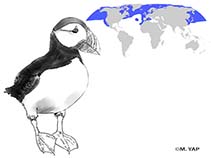Fratercula arctica (Linnaeus, 1758)
Atlantic puffin
Classification / Names Common names | Synonyms | CoL | ITIS | WoRMS
Aves | Charadriiformes | Alcidae
Environment: milieu / climate zone / depth range / distribution range Ecology
Others; depth range 0 - 60 m (Ref. 62202), usually 20 - 30 m (Ref. 62202). Polar; 83°N - 24°N, 85°W - 71°E (Ref. 124582)
Distribution Countries | FAO areas | Ecosystems | Occurrences | Introductions
Arctic, Northern Atlantic and the Mediterranean. Boreal to polar.
Length at first maturity / Size / Weight / Age
Maturity: Lm ? range ? - ? cm Max length : 30.0 cm TL male/unsexed; (Ref. 8812); max. published weight: 381.00 g (Ref. 356)
Short description Morphology
Life cycle and mating behavior Maturity | Reproduction | Spawning | Eggs | Fecundity | Larvae
Main reference
References | Coordinator | Collaborators
Barrett, R.T. and F. Rikardsen 1992 Chick growth, fledging periods and adult mass loss of Atlantic Puffins Fratercula arctica during years of prolonged food stress. Colonial Waterbirds 15(1):24-32. (Ref. 4091)
IUCN Red List Status
(Ref. 130435: Version 2025-1)
CITES status (Ref. 108899)
CMS (Ref. 116361)
Threat to humans
Human uses
| FishSource |
Tools
More information
Max. ages / sizes
Length-weight rel.
Length-length rel.
Length-frequencies
Mass conversion
Abundance
Maturity
Fecundity
Spawning
Eggs
Egg development
Larvae
Internet sources
BHL | BOLD Systems | CISTI | DiscoverLife | FAO(Publication : search) | Fishipedia | GenBank (genome, nucleotide) | GloBI | Gomexsi | Google Books | Google Scholar | Google | PubMed | Tree of Life | Wikipedia (Go, Search) | Zoological Record



